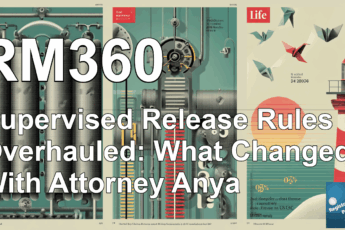H1: Navigating the Complex World of Plea Bargains: Key Differences Between Federal and State Court Processes
Introduction
Plea bargaining is one of the most critical—and misunderstood—aspects of the American criminal justice system. It forms the backbone of case resolution in both federal and state courts, dictating outcomes for the overwhelming majority of criminal prosecutions. Yet, beneath this widespread practice lies a complex interplay of structure, flexibility, and court culture that varies profoundly depending on whether a case is prosecuted at the federal or state level.
Recently, legal professionals Larry and Chance discussed the pushback and confusion surrounding these differences, especially after an episode on their podcast about federal versus state plea procedures. The feedback from listeners was clear: people want to understand not just the “how,” but the “why” behind these distinctions. In this article, we dive deep into how plea bargaining plays out in each system—drawing on their candid conversation, real-world anecdotes, and additional expert perspectives—to help demystify this crucial process.
We’ll walk you through:
– The structural differences between federal and state court plea processes
– Why flexibility (or a lack thereof) is so significant
– The role judges play in negotiations
– What this all means for defendants, attorneys, and the justice system as a whole
Whether you’re a legal professional, a defendant, or simply curious about how justice is really served, by the end of this article you’ll have a much clearer understanding of federal vs. state plea deals—and why it matters.
H2: Structure vs. Flexibility: The Key Distinction
One of the most striking differences between the federal and state plea bargaining processes lies in their underlying structure.
H3: The Rigid Formality of Federal Pleas
In the federal system, everything operates under strict rules:
– Every facet of a plea deal must be meticulously documented
– Negotiations involve multiple stakeholders: Assistant U.S. Attorneys, probation officers, sometimes various agencies
– All proposed deals must be run through a rigorous approval process before they ever reach the judge
– Federal judges are often constrained by mandatory sentencing guidelines and sentencing grids
As Chance explains, “There’s a lot less flex…than there is in the state. In federal court, everything has to be committed to paper, and you can’t deviate far from the foundational facts that led you to that plea to begin with.”
This formal structure means that, even after all involved parties agree, the judge retains tremendous authority to reject a plea—sometimes leaving the defendant and prosecution back at square one, if the proposal doesn’t fit the legal or factual parameters. As one commentator put it, “If the judge doesn’t like it, you’re still back where you started—and sometimes south, way south.”
H3: The Fluidity of State Court Bargaining
Contrast this with state court, where informality and flexibility are woven into the process:
– Negotiations between defense and prosecution are often verbal, not always formalized in writing
– Settlement discussions can—and often do—occur up until the last minute, even during trial breaks or after jury selection
– Judges are more likely to accept “on-the-spot” deals presented in open court, often with little pre-review
Larry paints a vivid picture: “On a day that they’re doing plea outs, they’ll have a zoo docket.… They’re working deals all the way up to the time that the case is called. Sometimes the defense attorney says, ‘Your Honor, we’re still working,’ and the judge just moves to the next case.”
The driving force behind this flexibility is efficiency. State courts often face overwhelming caseloads, so expediting cases through negotiated pleas serves both defendants and the system. Judges are incentivized to “move the docket,” and unexpected proposals are part of daily operation.
H2: The Role of the Judge: Referee or Negotiator?
How much do judges shape plea bargaining outcomes? The answer varies greatly between systems, and even within jurisdictions.
H3: The Gatekeeping Federal Judge
In federal court, the judge serves as a strict gatekeeper:
– The judge reviews every detail of the plea proposal, matched against sentencing guidelines, statutory limitations, and factual records
– If the judge finds any mismatch—or simply disagrees with the proposal—they may kick it back, requiring the parties to start over
Chance summarizes the weight of this oversight: “It is a tremendous burden to work out things in the federal system…You have to present it, and what moves you’ve gotta make. It’s a process.”
H3: The Negotiating State Court Judge
In state courts, judges frequently assume a more hands-on, even persuasive role in deal-making. Larry recalls the late Judge Pat Murdoch, who would openly counsel both sides about the limitations of their positions—prodding prosecutors and defense attorneys alike to reach realistic settlements.
An example Larry shares illustrates this dynamic:
-“Judge Murdoch would tell the state what was wrong with their case and the defense what was wrong with their defense…He’d say, counselor, your client is six foot three, she’s five one and a hundred pounds. The jury’s not going to believe you…”
Judges like Murdoch can accelerate resolution, using their insights to nudge parties toward practical, fair outcomes. However, others may prefer to let the adversarial process play out without much intervention—approaches often shaped by local court culture and individual philosophy.
H2: Caseflow and Practical Impacts on Defendants
H3: Efficiency and Flexibility in Action
State court’s flexibility often benefits everyone:
– Cases can resolve swiftly—even before arraignment—sometimes with just a phone call
– Judges value attorneys who clear their dockets efficiently, promoting early and creative settlements
– Defendants may enter more favorable deals thanks to open negotiation channels and fewer procedural hurdles
But this ad-hoc system has its drawbacks. As Larry and Chance acknowledge, defendants can be pressured to accept quick deals—sometimes by attorneys, sometimes by the circumstances of an overcrowded docket.
H3: Federal Formality Cuts Both Ways
While federal court’s rigor ensures careful scrutiny and theoretically more consistent results, it also raises the stakes:
– Negotiations are slower, with mandatory steps every party must follow
– Paperwork and reviews create barriers that make sudden or creative settlements difficult
– The risk if a deal is rejected can leave defendants “worse off” than before
Therefore, having skilled counsel who knows the ins and outs of federal plea bargains and the unique tendencies of individual judges is crucial. One misstep can upend months of negotiation—and have life-altering consequences.
H2: Is the Plea Process “Fair”? Impressions from Inside the System
The plea bargain’s reputation in the public sphere skews negative: it’s criticized as coercive, opaque, or a “rubber stamp” that sweeps cases under the rug. But both Larry and Chance offer a more nuanced take.
Larry comments, “Hopefully people were able to…understand that the plea process is not as bad as it’s vilified to be. It serves a useful purpose.” He concedes, “Do people get railroaded? Sometimes. But most of the time, it’s to defend its benefit because they’re facing such horrendous exposure if they don’t take proactive measures.”
Chance echoes this, stressing the importance of solid legal advice and judgment: “You’ve just got to know where you stand…and you’ve got to have a good idea of where things go from where you’re at. That takes some good advice and it takes some, you know, good judgment and effort.”
Research:
- According to the Pew Research Center, over 90% of both state and federal criminal cases are resolved by plea bargain, not trial. (Source: Pew, 2023)
- Scholars argue this volume—especially in state court—is driven by efficiency needs, while in federal court, strict guideline adherence aims for uniformity but can reduce creative solutions.
H2: Actionable Takeaways for Navigating Plea Bargains
Whether you’re a defendant, attorney, or simply observing the process, here are practical steps to keep in mind:
1. Understand the System: The rules and culture can vary drastically. Know whether your case is headed to state or federal court (or could move between them), and study local practices.
2. Communicate Early and Often: In both systems, early engagement between defense and prosecution can produce better outcomes. In state court, flexibility allows for last-minute negotiation; in federal court, building a careful case from the start is essential.
3. Seek Experienced Counsel: The complexity of plea bargaining—especially in federal court—means your choice of attorney matters. Find someone with direct experience, who is familiar with the preferences of local prosecutors and judges.
4. Ask About Alternatives: Not all pleas are created equal. Discuss all possible outcomes, including the consequences of going to trial, with your attorney.
Conclusion
Plea bargaining sits at the heart of American criminal justice, but it’s far from a one-size-fits-all process. The formality, documentation, and judicial oversight of federal courts create a landscape of rigid negotiation—one where every detail counts, and surprises are rarely welcome. State courts, by contrast, operate with tremendous flexibility, shifting the dynamic to one of expedient negotiations and rapid resolutions.
Each system brings strengths and weaknesses. For defendants, understanding these contrasts is vital. It could mean the difference between a carefully crafted deal or a pressured, last-minute agreement—the difference, in some cases, between freedom and incarceration.
In the words of those inside the system: it’s not perfect, but knowing the lay of the land, getting good advice, and staying proactive can tip the scales toward justice.
Further Reading & Resources:
– Pew Research Center: “The Role of Plea Bargains in the American Justice System”
– National Association of Criminal Defense Lawyers: “Federal vs. State Sentencing Guidelines”
– The Marshall Project: “How Plea Bargaining Became the American Way of Justice”




Leave a Comment